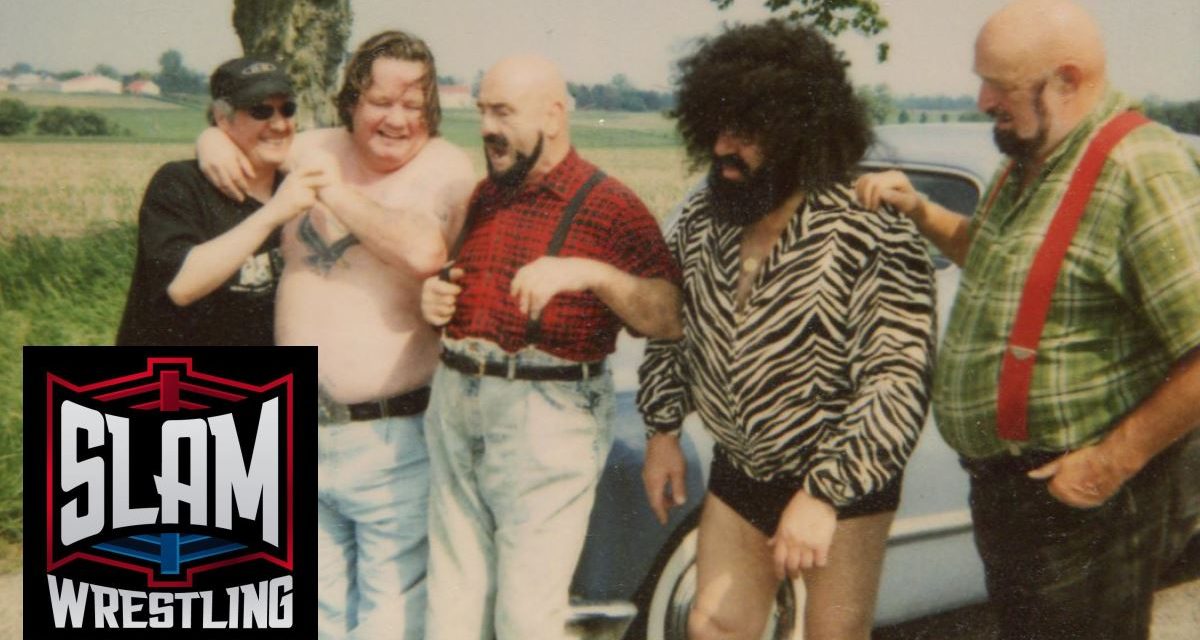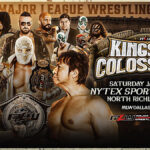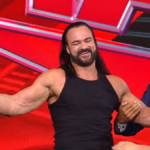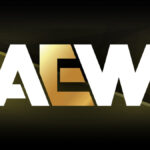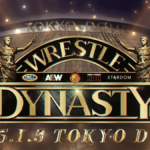Pre-production seemed to go on forever. I needed archival footage of the Dog but it was in short supply. WWF and AWA footage was too expensive. Ron Martinez had nothing, I couldn’t find Brian McFarlane, George Cry-Baby Cannon was AWOL, the CBC archival department had no idea if they had any, the Portland TV outlets tossed it out. I kept hitting dead ends.
But somewhere during that period, Butcher suggested trying CFCF in Montreal and it was a big relief when Bill Merrill got back to me. About to retire, Bill had produced the studio version of Grand Prix and had squirreled away some tape of the Dog and a few others. It was strange watching it — the pull was gone but the plaid suits and massive sideburns were an inspiration.
Photographs were next.
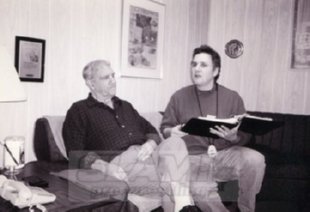
Tony Lanza in his basement with John Dolin.
I drove to Montreal and met with Tony Lanza, considered by many to be the greatest wrestling photographer to ever live. A journeyman wrestler who’d worked under so many different names — “one night I got booked against myself” — Tony’s real gift was being in the right place at the right time. He had a good eye and a keen understanding of the ebb and flow of a match. And after 50 years of working in Quebec, he’d shot every major star, match, signing, and Christmas party during Montreal’s hey day and the Dog was all over it. Remarkably, Tony had a collection of 29,000 negatives in his basement and none of them were catalogued.
When we met, Tony, at age 78, was past being organized and also liked talking metaphysics and advanced hypnocology — having earned a degree in it after studying for three days at the American Hynocology Institute in Chicago, he kept trying to put me under.
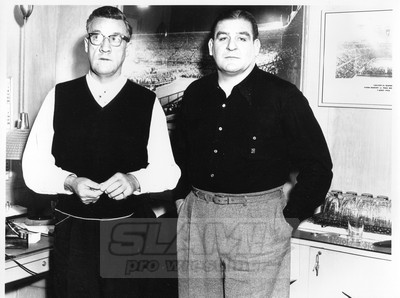
Eddie Quinn and Yvon Robert Jr. Photo by Tony Lanza
We spent the day time travelling: this is Eddie Quinn and Yvon Robert, oh here’s Maurice Vachon in his first match at the Forum, you are getting sleepy, this is Johnny Valentine and Buddy Rogers, this is Rocca, he was owned by the mob, oh and by way, I also trained several wrestlers down here. Down here, as in this basement? Yeah. Who? Lots of people: Dominic Denucci, Yvon Robert Jr., name a guy. The floor was still springy but the ceiling height was just over six feet; similar to Stu Hart’s set up but less the linger of water-boarding.
I had to go — I borrowed a small bundle of negatives then I humped it to the south shore to meet with the Butcher to go over the script. Butcher had driven in from his log cabin in the Green Mountains. Yes, he was living his lumberjack gimmick, in a house hewn from logs he’d cut and milled by hand. And it didn’t have electricity. I’m used to all this now but at the time, it was one weird moment after another.
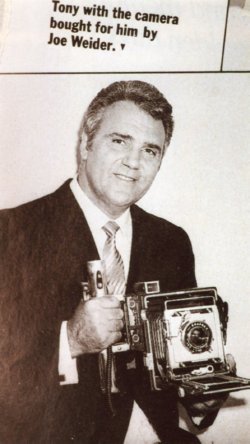
“I let the action come to me.”
Our first meeting went well and I got going on the script as soon as I returned home to Toronto. Ultimately, the writing process took several months. I elected to go without a narrator and get the full cast to help tell the Dog’s story, the thinking being who better to do it than the guys who were there? But figuring out who I needed to tell each story took time and I went down far too many rabbit holes searching for people I never found: a ref in Larry Kasaboski’s territory, the one-eyed guy who foolishly picked a fight with the Dog in Winnipeg at the Marlboro hotel in 1969, Dave Ruhl, Harry Madison — were they alive or dead? No one seemed to know. On and on it seemed to go.
***
The script laced career milestones with road stories and famous ribs the Dog helped engineer, like the Mabel he and the boys pulled on The Great Antonio in Calgary, in 1959. For those who haven’t heard the story, The Mabel is a prank that was occasionally pulled on rookie wrestlers by the vets. Antonio, a 450-pound Croat strongman known for stunts like pulling buses with his teeth, had just arrived in Calgary and was desperate for female company. That’s when he got a call from Mabel, a ringside hottie who was actually Dave Ruhl, a local wrestler with a knack for imitating lascivious women over the phone. As the Dog reported, Mabel told Antonio she’d seen him wrestle and thought he was handsome and that it might be an idea for them to get together as she was very lonely and oversexed.
BUTCHER: And my husband, he’s a pilot, he’s out of town, and he don’t understand me.
MAD DOG: So let’s get together at this address and bring a case of beer and some sandwiches!
STU HART: And bring some of that old kielbasa and Polish sausage, we’ll celebrate out at my place so I’ll meet you there.
I’m paraphrasing, but as the story goes, once Antonio took the bait, the Dog drove him to a house, “way out in the country,” said Stu Hart, where the Great Antonio hopped out of the car, carrying the beer and sandwiches.
BUTCHER: And who comes out from around the corner of the house but the husband, dressed as a pilot. And he’s carrying a shotgun!
STU HART: And he guy says, “You’re the bastard who’s screwing my bee-utiful wife!”
BUTCHER: And the Mad Dog gets in between them and says no, no don’t shoot! But he does, bang! And Mad Dog takes a bump!
MAD DOG: And Antonio (who thinks the Dog is dead) drops the beer and sandwiches and takes off into the fields.
STU HART: He takes off on the run, and I remember, I wasn’t there, but he ran right through a herd of horses and the horses snorted with fright. Great Antonio ran until he couldn’t run any more. He’d lay down and rest and then he’d run some more. You know he was a big, fat bastard anyway.
BUTCHER: And everyone in the territory comes out from behind the house: me, Dave Ruhl, Stu Hart, and we grab the beer and sandwiches and had a Mabel Party.
STU HART: They had corn beef sandwiches, and salami, and two cases of beer and maybe even a little wine with it even …
Overall, I’d say eight of the guys help tell that particular story — it was legendary in the business and some guys were actually there and some weren’t but said they were and Stu Hart, who knew it better than anyone, denied being there after admitting he’d seen it all unfold. The promoter in him wanted to cover his tracks, the wrestler didn’t, and he was at that age where he couldn’t keep his story straight. And that crazy sound he made — “eh eh eh” would fill a pregnant pause that would last 20 to 30 seconds. That really threw me during his interview. He’d just stop talking mid-stream, I’d ask if he was okay and get no response and then he’d start up, like a new lawnmower, without having missed a beat. It took a while to hit stride, but ultimately Stu’s version of the story was drop dead funny. He was a very clever guy who took time to summon the details and they were gold once he did. Stu also said the Mabel was “an awful thing to do to a person but that boys will be boys.” That was telling — The Mabel is a fairly nasty prank — Antonio ended up in the back of a police car, soaked from the waist down, so scared he couldn’t get out. (Stu guessed he got stuck.) Yet no one cared. Antonio was a wrestler and at the time, wrestlers lived and breathed the art of the swerve. Marks were marks; swerve the public, you may get a free meal. Swerve a wrestler, that was big currency in the locker room. And rookies were fresh meat. Of course, you took your life in your hands trying to pull stunts like this. Wrestlers were volatile — Harley Race told me payback with him was a bitch. And it was. In fact, a lot of guys paid a heavy price for going too far. But to my knowledge, no one ever swerved the Dog.
***
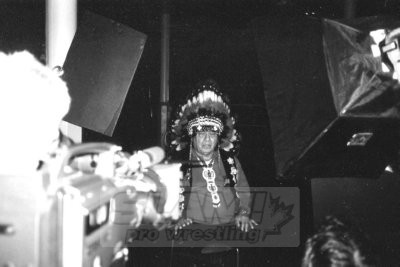
Billy Two Rivers was filmed, but not used in the final film.
Pre-production also involved my tracking a more Dog-friendly cast, which I didn’t mind doing. A lot of the guys who’d known Maurice through the years were more than happy to get involved. As a headliner, he’d scratched their backs, literally and figuratively, now it was their turn. Killer Kowalski, Billy Two Rivers, Moose Morowski, Yvon Robert Jr., Baron Von Raschke, Don Leo Jonathan, Stu Hart, Gino Brito, Don Owen, The Destroyer, Little Brutus, Gene Kiniski, Glen Parks, and even Ed Broadbent, the former leader of the NDP, signed up. Incidentally, I’m not sure anyone buys more hair dye than retired wrestlers. It’s so “they wouldn’t disappear” as the Dog put it. Killer Kowalski might have been the exception. But he wore a hair piece that defied logic: ill-fitting, black as coal, it looked like a beer cap on a yellow gourd. But it worked for him — I liked it, it was a kooky way of saying I still got game.
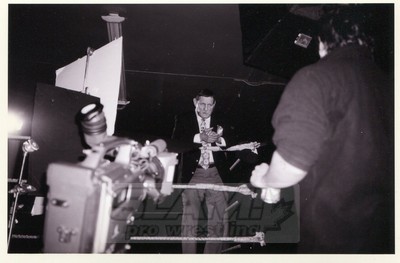
Killer Kowalski on set.
KILLER KOWALSKI: In the mid ’70s, Mad Dog and I were tag team partners, and the people were just going crazy and some geek jumped over the ring and grabbed Mad Dog’s foot. He ripped his foot out and kicked the guy in the face. So he (the geek) brought it to court. In court, I testified with them (on behalf of Mad Dog), and it looked great, and we went out to lunch and figured we’re gonna beat this guy. Back in court the lawyer came over to Mad Dog and mentioned to him, “Look you’re just a small guy you don’t even look like a wrestler, and that blew him apart, and he screamed, “If anybody touches me I’ll break his neck! I kill them all!” That was the end of the whole thing. When he said that, I walked out. Case ended, we lost.
Typically when you cast a project, you don’t do it over the phone, but I was feeling good — the road stories Butcher had shared were hilarious and the Dog was game and the supporting cast sounded equally engaging. Dick Beyer, The Sensational, Intelligent Destroyer, was around Maurice throughout his career and could spin a serious yarn, plus he had camera chops. In addition to his years on TV as a wrestler, I learned Beyer had become a cult figure in Japan where he’d had been a regular on a variety series. Hearing that was heartening; it meant he’d be good on camera. Beyer was great on camera: ribald, funny and very astute.
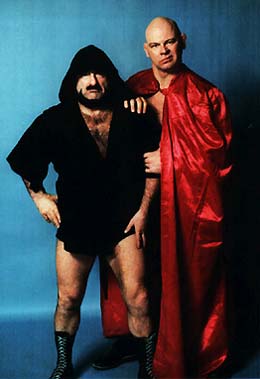
The Mad Dog and the Baron.
But most interesting was Baron Von Raschke, one of the great Teuton terrors of the ’60s and ’70s.
When I first got in touch, the Baron lived in Lake George, Minnesota and was selling lawn gnomes. Bonnie answered the phone and shrieked, “Jim!!” On bad knees I’m now picturing him slowly getting out of his chair to come to the phone. It was like waiting to speak with Adam West, knowing Batman had retired, after believing he’d been real.
“That was my wife,” the Baron deadpanned, sans growl, before saying hello. “We’ve been married 31 years. Five of them were happy.” I howled, he laughed, the ice was broken and for once I didn’t have to do it. In the background, Bonnie sing-songed, “I heard that.”
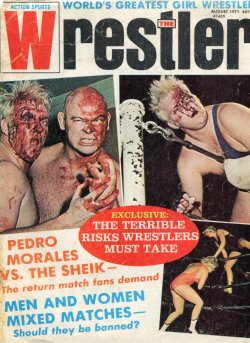
Right away, the Baron revealed himself; he was thoughtful, well-spoken and extraordinarily polite, and very devoted to the Dog. It turned out Maurice had had a fairly profound influence on him.As with the Dog, my only exposure to the Baron as a kid was through back issues of wrestling mags given to me one Christmas by my Mom (who did take me to the matches and recently recalled our fleeing a riot at the Gardens).
THE BARON: In the ring he was intense, CRIB HE TOOK SERIOUS! He was real zealous about cribbage. We flew a lot at the time, and in the plane he got a hold of me and said (GROWLING), I’ll teach you how to play cribbage. Every time you played a card, he’d say SAY IT! If I was a little late, he’d say PLAY IT, SAY IT, PLAY IT!! He was drivin’ me nuts!! Yeah, it’s a game but he was always the Mad Dog.
In addition to teaching him how to play crib, the Dog helped Jim Raschke come out of his shell, if only by example. When Raschke turned pro, he was a shy, bashful kid who couldn’t get a handle on the interviews he had to cut. Because his wrestling pedigree was excellent — Raschke had represented the United States as an amateur on several world teams — the athletic challenges of the pro game were met with relative ease. But Jim struggled to connect with his audience, something that was and is essential to success in the pro ranks.
THE BARON: Back in 1966 when I broke into professional wrestling, I’d just left a job as a full-time teacher and I wasn’t used to all the interviews and the cameras and it was very hard for me to talk to the public. I’m by nature a very shy bashful person and, ahh, I wasn’t pickin’ up on the interview aspect of our business which was so important. Mad Dog was he was the world champion in the AWA at the time. He was one of the best interviews in the world, he was a great wrestler and a great interview and I just couldn’t pick up, I couldn’t get over bein’ Jim Raschke, all the psychological factors whatever it was, it wouldn’t let me overcome my shyness, my bashfulness and I’d get in there and say, “Aw shucks, I’m Jim Raschke,” and it was like a typical high school interview that kids practise in their speech or whatever. And then Mad Dog came along and we met and he took me, he had me meet him up in Quebec, Canada. At the time he suggested I become a use my ethnic background and become a German and become a German wrestler. I said fine. He wanted to name me Baron Von Pumpkin by the way and I said, ‘Naw, that sounds a little funny to me. I don’t know what Pumpkin means. I said I’ll just use my last name.” (In Mad Dog voice) “OKAY YOU CAN BE BARON VON RASCHKE!” I said, “OKAY MAD DOG, I’LL BE BARON VON RASCHKE!” And somehow everything clicked and we revitalized the territory and by the end of the season we were having sell outs every night. Anyway that’s where little shy Jimmy Raschke from Nebraska was thrown to the background and (GROWLING) Baron Von Raschke the wrestler became a big name in the profession because he could interview with the best of them, I suppose, and carry on and that’s really all you need to know about that!
The drive to the Baron’s shoot was positively dreamy. The highway from Minneapolis to Lake George is littered with fireworks stores that sell delicious Budweiser in icy-cold cans with super nice white and red trim that I paid serious attention to en route. I was really excited — I was going to meet the Baron.
The shoot itself could not have gone better. Jim was candid and introspective and the Baron more manic than ever. And just like the Dog, Jim would slip in and out of character without prompting, often times unintentionally. Different was that the Dog would howl with laughter when he’d gone too far while the Baron would stop very suddenly and we’d quietly discuss if there was a problem with his performance. Very different people but it was all like winning the lottery — such great fun to be a part of. And for the record, The Dog never gave Jim acting lessons or pointers about developing his character. In 1967, after they’d agreed to work in Quebec, Jim drove up to Chicoutimi to meet the Dog where they’d start their run as a tag team. On the Dog’s instructions, Jim had gotten a cape and some black trunks to look the part, but as to the Baron’s character and voice, that was something that would emerge on the fly.
For some reason, Jim was booked in a single match on his first night there, but the Dog wanted to introduce the Baron as his partner, so prior to the match, he joined Jim in the ring and started an interview at full throttle, leaving Jim no option but to match his intensity.
THE BARON: And the Dog said a few words and his interview, of course, was fantastic and from his flow I just took off and became the Baron.
From what I understand, and this would be typical of the Dog, they didn’t discuss what to say or how to say it, it just happened: the rasp, the German accent, the imperious attitude, The Baron was born following the Dog’s lead. And genuinely fascinating was how that experience would effectively change Jim’s life.
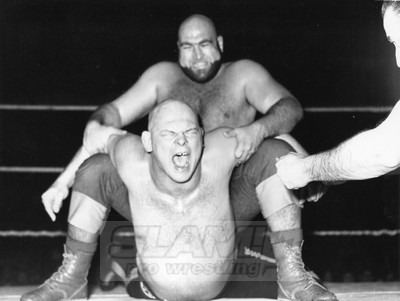
The Baron vs. Jos Leduc, early ’70s. Photo by Tony Lanza
THE BARON: Once I became the Baron, all those inhibitions I had, all those deep psychological restrictions I put on myself, they were completely wiped out. I became Baron Von Raschke and the Baron could do just about anything he wanted. (BECOMING THE BARON) The Baron wanted to say he could just say it. All of his ideas and all of his remarks, there were no repercussions because the Baron was a completely different person and that is all that people need to know!
Of everyone I got to know, I suspect Jim was closest to Maurice, next to Paul. Remarkable was how the Baron and the Mad Dog, shot weeks apart, a thousand miles apart, could revisit an event from 30 years prior and rail in character as if they were standing side by side. From what I witnessed, their chemistry and friendship had stayed rock solid over the years and obviously Jim treasured their time together. “Whatever people think of him,” he added, “He’s got the mind of a genius for the wrestling business. He knows things before other people know them, he knows how to make things come out right, he’s amazing to me.”
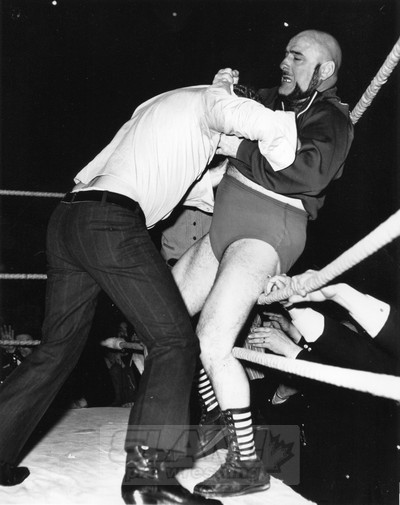
Yvon Robert. Jr.: “In 1972, everybody in Montreal started to talk like Mad Dog: your parish priest, your mom, everyone.”
MAD DOG: Guys like Pat O’Connor take years and years to get their message across. (SHIFTS INTO MAD DOG GROWL) But when I go on TV, I’m the Mad Dog, and I talk and the people say, “Oh yeah you make believe because you talk like that.” I say I talk like that because I was injured in the throat, and you file your teeth and I say those teeth were knocked down my throat, that’s why I’m like that, that’s why I look like the Mad Dog that’s why I became the Mad Dog so when I make an interview one interview like this it takes other guys years and years to get over — to get their message over — to people when they meet — I’m there to beat the living sh** right out of you, and I do it and it’s a dog eat dog world as far as I’m concerned.
PAGE 1 | PAGE 2 | PAGE 3 | PAGE 4 | PAGE 5 | PAGE 6
Maurice “Mad Dog” Vachon story archive
